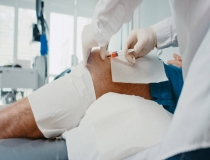The human body has an incredible ability to heal itself. In recent years, researchers have been able to harness this remarkable healing ability and amplify the natural growth factors the body uses to heal tissues all over the body through platelet-rich plasma (PRP).
PRP has two main components: plasma, the liquid portion of the blood, and platelets, tiny blood cells that help the body form clots and facilitate healing. Blood platelets contain growth factors that trigger cell reproduction and stimulate tissue regeneration, while plasma serves as its transport medium.
Combined, both components are used to create blood plasma injections that are increasingly used to treat sports injuries, hasten post-surgical recovery, and prevent hair loss, among others.
Learn more about PRP injections, the benefits and risks associated with injecting plasma, and how to prepare for a plasma platelet injection below.
What is PRP Injection Therapy?
PRP injection therapy is a method of treatment that uses the patient’s own blood components to accelerate the healing of injured tendons, ligaments, joints, and muscles.
These injections are prepared by collecting blood samples from the patient, which are then ran through a centrifuge to separate the red blood cells from the platelets and plasma. The now-concentrated plasma is injected directly into the injured tissue to take advantage of growth factors and stimulate regeneration.
Although the mechanism behind PRP injections has not been fully understood yet, studies have shown that the shorter healing time is due to the increased concentration of growth factors in the injected region. And by using the patient’s own blood samples in the treatment, injecting plasma rich in platelets has proven to be an excellent way to harness the body’s healing capabilities to heal itself.
What is PRP Injection Treatment Used For?
The full capabilities of PRP injection treatment are still being explored. But currently, it has found a number of applications, including:
- Treatment of tendon injuries, including tennis elbow, Achilles tendonitis, and patellar tendinopathy (jumper’s knee)
- Acute injuries such as knee sprains and pulled hamstring muscles
- Osteoarthritis
- Accelerated post-surgical recovery by promoting healing of the wound
- Skin rejuvenation and anti-ageing treatments
- Promoting hair growth and preventing hair loss
What are the Benefits of PRP Injections?
Although more research is required to identify the full benefits of PRP injections, clinical studies thus far have shown the incredible benefits of PRP injection therapy. These include:
Faster Recovery of Sports-Related Injuries
PRP therapy is an appealing treatment option for athletes who have experienced tendon, joint, ligament, muscle, and other soft-tissue-related injuries. Injecting plasma into affected areas can promote healing in the affected areas and shorten the timeline for recovery, allowing them to return to their sport in less time.
Symptomatic Relief From Osteoarthritis
Patients suffering from osteoarthritis frequently experience severe knee pain due to the lack of lubrication and cushioning in the affected knee joint. However, PRP therapy can restore hyaluronic acid, the primary lubricating agent in the knee, relieve the symptoms of osteoarthritis and prevent the progression of the condition.
Reduction and Healing of Inflammation
PRP therapy also offers pain management properties that effectively reduce inflammation and swelling in injured body parts.
Provides Lasting Relief For Lower Back Pain
PRP therapy has been shown to help treat chronic back pain, which has been known to be challenging to treat. By promoting recovery in structural elements that contribute to pain in the lower back, such as discs, ligaments, and joints, this treatment method has been able to provide relief for patients who have been suffering from chronic back pain for quite some time.
Minimally Invasive Treatment Method
All facets of the treatment method are minimally invasive, from the collection of blood samples to the actual treatment. After preparation of the PRP injection, the sample is injected directly into the affected area, which offers relief after allowing the body to recover. This eliminates the need for invasive surgical procedures.
Common Risks of Blood Plasma Injections
The risk for allergic reactions and other side effects is significantly lower as a minimally-invasive treatment method using the body’s own plasma. However, some patients experience lightheadedness after a blood draw, so make sure to stay hydrated. Others report soreness and bruising at the injection site.
Some less common side effects may include:
- Bleeding
- Tissue damage
- Infection
- Nerve injuries
Duration of Treatment and Recovery
PRP injection treatment sessions typically do not last more than an hour. After the treatment session, your physician will recommend that you rest the affected area to facilitate recovery. This is because although PRP treatment cuts your recovery time significantly, you will still need some time to heal.
Plasma injections are not made for instant healing. They are intended to promote healing or growth, but it will take time before you can feel their effects. Typically, patients will begin healing several weeks or months after receiving an injection in the affected area. At this point, the body will heal faster than ever, accelerating your recovery timeline.
Preparing For Plasma Platelet Injection Therapy
Plasma platelet injection therapy is a safe, low-risk procedure that offers plenty of benefits. However, it is still recommended that you take several precautions prior to getting treatment for optimum results. The following are some recommendations you can follow while preparing for injection therapy:
- Stop taking medications that thin your blood, such as aspirin and ibuprofen.
- Avoid taking vitamins and supplements that affect the consistency of your blood, such as vitamin E and omega-3 fatty acids.
- Eat a full meal before the procedure to avoid feeling lightheaded.
- Do not wash the treated area for about 48 hours.
Additionally, patients with low or abnormal platelet counts, anemia, cancer, and infections cannot get PRP injections. So make sure to consult with your doctor before getting treatment.
Get PRP Treatment From a Licensed Expert
Platelet-rich plasma injection therapy offers a wide range of benefits to help you recover from sports-related injuries, chronic joint and tendon pain, and other musculoskeletal conditions you may be experiencing.
At Chicago Stem Cell Therapy and Regenerative Medicine, we provide patients with complete care and advanced treatment options to help them get back to their everyday routines. If you or a loved one are considering regenerative care and would like to explore your options, speak to our medical experts to learn more about the benefits of regenerative medicine procedures.


 Thanks a lot for getting my hip right. Looking forward to a full recovery and a great season. Thanks again for everything.
Thanks a lot for getting my hip right. Looking forward to a full recovery and a great season. Thanks again for everything.










